Preparation Of Cationic Surfactants
Zhang; Xuan ; et al.
U.S. patent application number 17/551915 was filed with the patent office on 2022-04-07 for preparation of cationic surfactants. This patent application is currently assigned to Saudi Arabian Oil Company. The applicant listed for this patent is Saudi Arabian Oil Company. Invention is credited to Ming Han, Jinxun Wang, Xuan Zhang.
| Application Number | 20220106260 17/551915 |
| Document ID | / |
| Family ID | |
| Filed Date | 2022-04-07 |
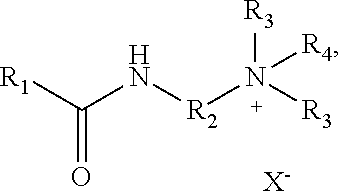



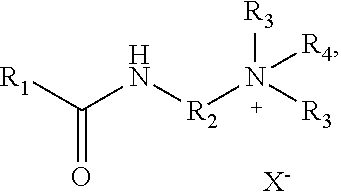
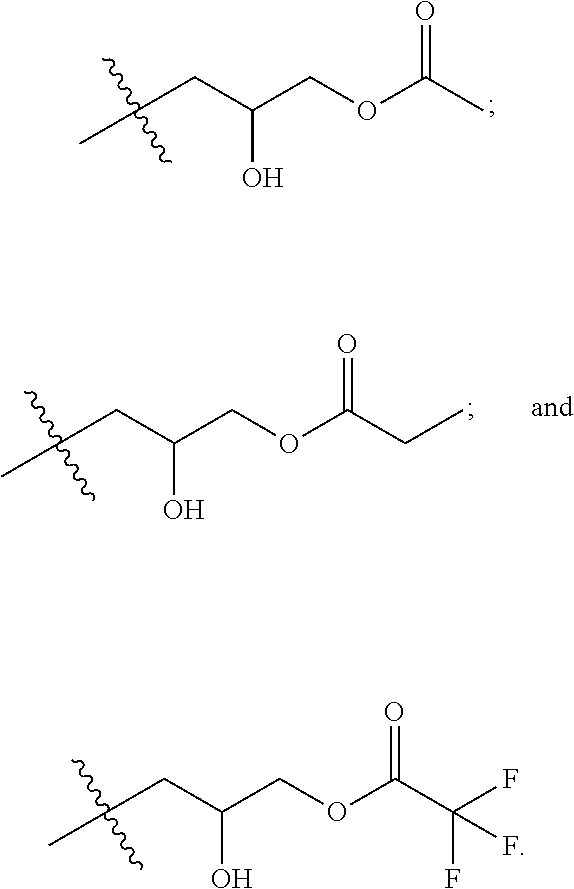


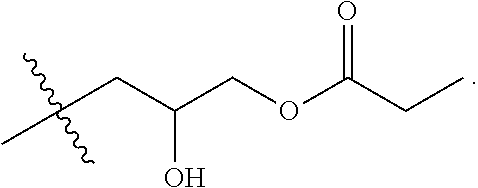
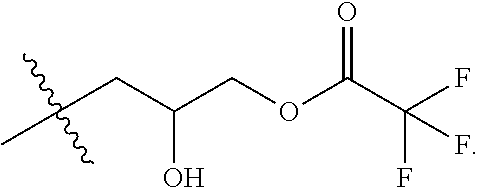

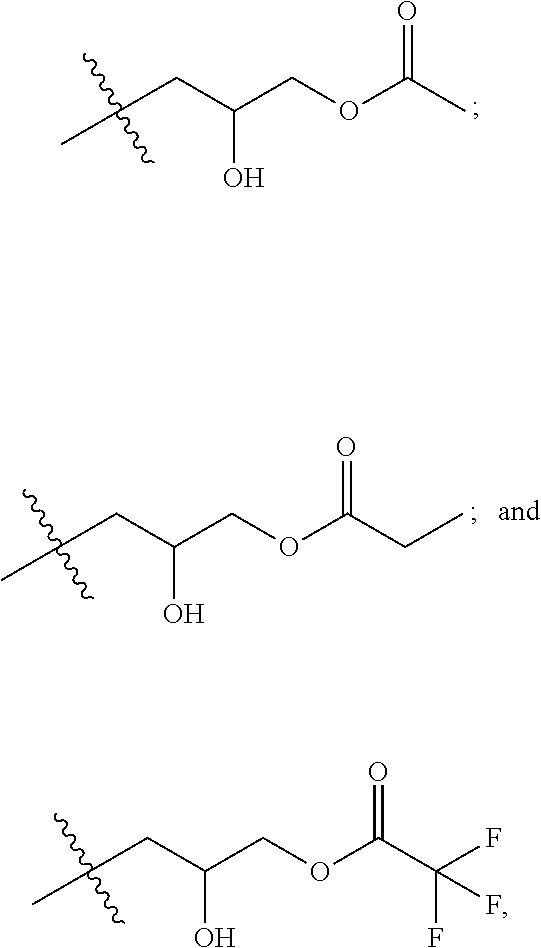
View All Diagrams
| United States Patent Application | 20220106260 |
| Kind Code | A1 |
| Zhang; Xuan ; et al. | April 7, 2022 |
PREPARATION OF CATIONIC SURFACTANTS
Abstract
Compositions that include cationic surfactants and methods of synthesizing compositions that include cationic surfactants. The surfactants include a quaternary amine and a saturated or unsaturated alkyl chain with 4 to 28 carbons. The surfactants can be generated by reacting a fatty acid modified with an amino alkyl group and an epihalohydrin in the presence of a base. The cationic surfactants can be generated by reacting a fatty acid modified with an amino alkyl group, an epihalohydrin, and a carboxylic acid. The cationic surfactants can be generated by reacting a carboxylic acid, an epihalohydrin, and a catalyst to afford a halo-substituted alkyl ester, followed by reacting the halo-substituted alky ester with a fatty acid modified with an amino alkyl group.
| Inventors: | Zhang; Xuan; (Beijing, CN) ; Han; Ming; (Dhahran, SA) ; Wang; Jinxun; (Dhahran, SA) | ||||||||||
| Applicant: |
|
||||||||||
|---|---|---|---|---|---|---|---|---|---|---|---|
| Assignee: | Saudi Arabian Oil Company Dhahran SA |
||||||||||
| Appl. No.: | 17/551915 | ||||||||||
| Filed: | December 15, 2021 |
Related U.S. Patent Documents
| Application Number | Filing Date | Patent Number | ||
|---|---|---|---|---|
| 16942565 | Jul 29, 2020 | |||
| 17551915 | ||||
| International Class: | C07C 237/52 20060101 C07C237/52; C09K 8/584 20060101 C09K008/584; C07C 233/38 20060101 C07C233/38; C07C 233/36 20060101 C07C233/36; C07C 231/02 20060101 C07C231/02 |
Claims
1. A process comprising reacting: a fatty acid modified with an amino alkyl group; and an epihalohydrin, in a presence of a base, to afford a cationic surfactant.
2. The process of claim 1, wherein reacting the fatty acid modified with an amino alkyl group comprises reacting N, N-dimetyl-erucyl-1,3,-propylenediamine.
3. The process of claim 1, wherein reacting the epihalohydrin comprises reacting epichlorohydrin.
4. The process of claim 1, wherein reacting in the presence of a base comprises reacting in a presence of sodium hydroxide.
Description
CROSS-REFERENCE TO RELATED APPLICATIONS
[0001] This application is a divisional of and claims the benefit of priority to U.S. patent application Ser. No. 16/942,565 filed on Jul. 29, 2020, the entire contents of which are incorporated by reference in its entirety.
TECHNICAL FIELD
[0002] This document relates to cationic surfactants and methods of preparation of cationic surfactants.
BACKGROUND
[0003] Surfactants are useful in many household and commercial applications. For example, new surfactants that are soluble and stable under harsh conditions would be useful in oil and gas recovery.
SUMMARY
[0004] This disclosure describes cationic surfactants composed of erucyl amidopropyl groups, with different head groups introduced by reaction with an epihalohydrin. This disclosure also describes one- and two-step methods of producing the cationic surfactants.
[0005] In some implementations, a composition includes a compound of Formula I:
##STR00001##
where X is halide, Ri is a saturated or unsaturated alkyl with 4 to 28 carbons, R.sub.2 is alkyl, R.sub.3 is methyl, and R.sub.4 is selected from the group consisting of
##STR00002##
[0006] In some implementations, a composition includes a compound of Formula II:
##STR00003##
where R is selected from the group consisting of:
##STR00004##
and where X is halide.
[0007] In some implementations, a process includes reacting a fatty acid modified with an amino alkyl group and an epihalohydrin, the presence of a base, to afford a cationic surfactant.
[0008] In some implementations, a process includes reacting a fatty acid modified with an amino alkyl group, an epihalohydrin, and a carboxylic acid to afford a cationic surfactant.
[0009] In some implementations, a process includes reacting a carboxylic acid, an epihalohydrin, and a catalyst to afford a halo-substituted alkyl ester. The process includes reacting the halo-substituted alkyl ester with a fatty acid modified with an amino alkyl group to afford a cationic surfactant. The details of one or more implementations of the disclosure are set forth in the accompanying drawings and the description that follows. Other features, objects, and advantages of the disclosure will be apparent from the description and drawings, and from the claims.
DESCRIPTION OF DRAWINGS
[0010] FIG. 1 shows an example structure of a cationic surfactant.
[0011] FIG. 2 is a flow chart of an example method for the quaternization of a tertiary amine.
[0012] FIG. 3 is an example reaction of N, N-dimethyl-erucyl-1,3-propylenediamine with epichlorohydrin.
[0013] FIG. 4 is a flow chart of an example method of a two-step synthesis of cationic surfactants.
[0014] FIG. 5A is an example reaction of a carboxylic acid and epichlorohydrin, catalyzed by tetrabutylammonium bromide.
[0015] FIG. 5B is an example reaction of N,N-dimethyl-erucyl-1,3,-propylenediamine with the chloro-hydroxyl alkyl ester synthesized in FIG. 5A.
[0016] FIG. 6 is a flow chart of an example method of a one-step synthesis of cationic surfactants.
[0017] FIG. 7 is an example reaction of N,N-dimethylerucyl-1,3,-propylenediamine, a carboxylic acid, and epichlorohydrin.
[0018] FIG. 8 is an example IR spectrum of erucyl amidopropyl-2,3-dihydroxypropyl ammonium chloride.
[0019] FIG. 9 is an example .sup.1HNMR spectrum of erucyl amidopropyl-2,3-dihydroxypropyl ammonium chloride.
[0020] FIG. 10 is an example IR spectrum of erucyl amidopropyl-2-hydroxy-3-acetoxypropyl ammonium chloride.
[0021] FIG. 11 is an example .sup.1HNMR spectrum of erucyl amidopropyl-2-hydroxy-3-acetoxypropyl ammonium chloride.
[0022] FIG. 12 is an example IR spectrum of erucyl amidopropyl-2-hydroxy-3-(2, 2, 2-trifluoroacetoxy) propyl ammonium chloride.
[0023] FIG. 13 is an example .sup.1HNMR spectrum of erucyl amidopropyl-2-hydroxy-3-(2, 2, 2--trifluoroacetoxy) propyl ammonium chloride.
[0024] FIG. 14 is an example IR spectrum of erucyl amidopropyl-2-hydroxy-3-propionyloxy propyl ammonium chloride.
[0025] FIG. 15 is an example .sup.1HNMR spectrum of erucyl amidopropyl-2-hydroxy-3-propionyloxy propyl ammonium chloride.
[0026] Like reference symbols in the various drawings indicate like elements.
DETAILED DESCRIPTION
[0027] Reference will now be made in detail to certain embodiments of the disclosed subject matter, examples of which are illustrated in part in the accompanying drawings. While the disclosed subject matter will be described in conjunction with the enumerated claims, it will be understood that the exemplified subject matter is not intended to limit the claims to the disclosed subject matter.
[0028] Provided in this disclosure, in part, are cationic surfactants and methods of producing cationic surfactants. These surfactants are useful in enhanced oil recovery applications. For example, many carbonate reservoirs have high temperatures and high brine salinity. Currently available surfactants and polymers have limited utility in these high temperature, high salinity formations. Accordingly, it is essential to develop new surfactants that are stable and useful at high temperature and high salinity situations. In addition, the surfactants with ultra-low interfacial tension, for example tension below 10.sup.-3 mN/m, are useful for releasing trapped oil in a reservoir. Accordingly, there is a need for surfactants that are stable at high temperature and high salinity formations that also display low or ultra-low interfacial tension with brine solutions.
[0029] FIG. 1 shows the structure of an example cationic surfactant. In some implementations, the surfactants include a hydrophobic tail Ra, an alkyl spacer where n=1 to 6, and a cationic amine with two methyl groups and a functional group Rc. The resulting cationic surfactants, described in more detail below, are stable in high temperature and high salinity environments. Accordingly, these surfactants are useful in drilling and oil recovery applications, for example, for chemical flooding in a carbonate wellbore.
[0030] In some implementations, the hydrophobic tail Ra is derived from a saturated or unsaturated fatty acid with 4 to 28 carbons. The fatty acid tail can be branched, unbranched, saturated, or unsaturated in either a cis- or trans-configuration. The properties of the fatty acid tail can influence the properties of the surfactant, for example, by influencing the melting point, stability, solubility, or the critical micelle concentration of the surfactants in seawater.
[0031] In some implementations, the surfactants include ultra-long fatty acid chains, for example chains of 18 or more carbons. In some implementations, the fatty tail can be derived from erucic acid, a monounsaturated C.sub.22:1.omega.9 fatty acid. Ultra-long fatty acid chains are very hydrophobic and typically not soluble in high salinity environments. However, the cationic surfactants described in this application have low interfacial tension and can be used in high salinity environments.
[0032] In some implementations, the fatty acid head group is modified with an alkyl spacer. For example, the carboxylic acid head group of a fatty acid can be reacted with an alkyl amine to form an amide bond between an alkyl spacer and a fatty acid. The alkyl spacer can be saturated alkyl group containing 1 to 6 carbons. For example, the spacer can be a propyl group. In some implementations, the spacer can include a tertiary amine functional group. This tertiary amine can be quaternized. For example, the reaction between a tertiary amine and an epihalohydrin results in a quaternary amine.
[0033] Quaternization of the tertiary amine introduces functional group Rc and results in the cationic surfactant. The positively charged amine of the cationic surfactant influences the solubility and stability of the surfactants. For example, in high-salinity environments the cation can reduce surfactant adsorption in carbonate reservoirs. The cation can also improve the stability of the surfactant at high salinity environments, for example in brines with high concentrations of divalent ions such as Ca.sup.2+ and Mg.sup.2+.
[0034] Quaternization of the tertiary amine can be achieved by a reaction with an epihalohydrin. For example, epichlorohydrin can quaternized the tertiary amine. Other epihalohydrins can also quaternized the tertiary amine. This results in an amine functionalized with an epoxy group. Under basic conditions, the epoxy can hydrolyze, yielding a dihydroxy functional group.
[0035] FIG. 2 shows an example flow chart of a reaction scheme 200 for quaternization of a modified fatty acid. At 202, a fatty acid modified with a tertiary amine is combined with an epihalohydrin in a 1:1 molar ratio in a solvent. Suitable epihalohydrins include epichlorohydrin. At 204, the mixture is stirred, with heating, for 5-24 hours. At 206, the pH of the mixture is decreased to induce a basic condition. At 208, the solvent is removed from the mixture. At 210, the product is recrystallized. At 212, the final product is obtained by filtration.
[0036] An example of the reaction scheme 200 is shown in FIG. 3, where N, N-dimethyl-erucyl-1,3-propylenediamine is reacted with epichlorohydrin. This functionalizes the quaternary amine with an epoxide. Under basic conditions, the epoxide can hydrolyze, yielding a 1,2-dihydroxylpropyl functional group. Recrystallization of the product results in the cationic surfactant erucyl amidopropyl-2,3-dihydroxypropyl ammonium chloride.
[0037] Cationic surfactants can also be synthesized using a two-step process 400. FIG. 4 shows an example flow chart of a reaction scheme 400 to synthesize cationic surfactants. At 402, a carboxylic acid is combined with an epihalohydrin at a 1.25:1 to 2:1 molar ratio in the presence of a catalyst. The choice of carboxylic acid can be used to introduce additional functional groups, such as hydroxyl, ester, or polymerizable groups such as a vinyl double bond. At 404, the mixture is stirred with heating for 5-20 hours. At 406, the pH of the mixture is adjusted to approximately 7. At 408, the mixture is filtered to obtain the halogenated alkyl ester product. At 410, the halogenated alkyl ester is mixed with a modified fatty acid that contains a tertiary amine. At 412, the mixture is refluxed for 5-24 hours. At 414, the solvent is removed. At 416, the product is recrystallized. At 418, the final product, the cationic surfactant, is obtained by filtering.
[0038] FIG. 5A shows an example reaction of the first step of the two-step process 400 between a carboxylic acid (COOR) and epichlorohydrin, catalyzed by tetrabutylammonium bromide (TBAB). Suitable carboxylic acids include, but are not limited to, acetic acid (R=--CH.sub.3), trifluoroacetic acid (R=--CF.sub.3), and propionic acid (R.dbd.--CH.sub.2--CH.sub.3). FIG. 5B shows an example reaction of the second step of the two-step process 400, where N,N-dimethyl-erucyl-1,3,-propylenediamine is combined with the chloro-hydroxyl alkyl ester synthesized in FIG. 5A. This generates a cationic surfactant that is compatible with brine solutions and has low oil-brine interfacial tension.
[0039] In some implementations, the cationic surfactants can be synthesized using a one-step process. In the one-step process, a carboxylic acid, an epihalohydrin, and an alkyl-modified fatty acid containing a tertiary amine are reacted to generate the cationic surfactant. FIG. 6 shows an example flow chart of a reaction scheme 600 for a one-step synthesis of cationic surfactants. At 602, a modified fatty acid that contains a tertiary amine is combined in solution with a carboxylic acid in a 1:1 molar ratio. At 604, the mixture is refluxed for 0.5-2 hours. At 606, an epihalohydrin is added to the mixture, in a 1:1:1 ratio with the modified fatty acid and carboxylic acid. At 608, the mixture is stirred with heating for 5-24 hours. At 610, the solvent is removed. At 612, the product is recrystallized. At 614, the final product, the cationic surfactant, is obtained by filtering. FIG. 7 shows an example reaction of the one-step process 600, where N,N-dimethylerucyl-1,3,-propylenediamine is combined with a carboxylic acid and epichlorohydrin to yield the cationic surfactant. Suitable carboxylic acids include, but are not limited to, acetic acid (R.dbd.--CH.sub.3), trifluoroacetic acid (R.dbd.--CF.sub.3), and propionic acid (R.dbd.-CH.sub.2-CH.sub.3).
EXAMPLES
[0040] Tables 1 and 2 summarize the reactants for the one- and two-step synthetic processes, described in more detail below.
TABLE-US-00001 TABLE 1 Summary of One-Step Processes, Examples 1, 3, 5, and 7 Example 1 3 5 7 modified N,N-dimethyl- N,N-dimethyl- N,N-dimethyl- N,N-dimethyl- fatty acid erucyl-1,3- erucyl-1,3- erucyl-1,3- erucyl-1,3- propylenediamine propylenediamine propylenediamine propylenediamine epoxide epichlorohydrin epichlorohydrin epichlorohydrin epichlorohydrin carboxylic none - base to open acetic acid trifluoroacetic acid propionic acid acid epichlorohydrin ring
TABLE-US-00002 TABLE 2 Summary of Two-Step Processes, Examples 2, 4, and 6 Example 2 4 6 carboxylic acetic acid trifluoroacetic acid propionic acid acid epoxide epichlorohydrin epichlorohydrin epichlorohydrin catalyst TBAB TBAB TBAB fatty acid N,N-dimethyl- N,N-dimethyl- N,N-dimethyl- erucyl-1,3- erucyl-1,3- erucyl-1,3- propylenediamine propylenediamine propylenediamine
Example 1
Synthesis of Dihydroxyl Group: Erucyl Amidopropyl-2, 3-Dihydroxypropyl Ammonium Chloride (C.sub.22APDAC)
[0041] 50 mmol of N, N-dimethyl-erucyl-1, 3-propylenediamine and 55 mmol of epichlorohydrin were dissolved in 30 mL of ethanol. The mixture was stirred at 65.degree. C. for 7 hours. Next, 50 mmol of NaOH was added to the mixture by adding 6.67 ml of 30 wt % NaOH solution, and the mixture was continuously stirred for 3 hours. After 3 hours, the ethanol solvent was removed under reduced pressure. The synthesized product was recrystallized in acetone and refrigerated at -15.degree. C. for 48 hours. Following refrigeration, a light yellow paste was obtained by filtering. The yield of erucyl amidopropyl-2-hydroxy-3-acetoxypropyl ammonium chloride (C.sub.22APDAC) was 76.1% by weight.
[0042] FIG. 8 shows an example infrared (IR) spectrum of C.sub.22APDAC, confirming the structure of C.sub.22APDAC as synthesized in Example 1. The wide absorption at 3290 cm.sup.-1 is due to the --N--H stretching vibration and the --O--H stretching vibration. The peaks at 2921 cm.sup.-1 and 2857 cm.sup.-1 are the stretching vibrations of the --CH.sub.3 and --C--H--(--CH.sub.2--) groups, respectively. The peak at 1651 cm.sup.--1 is the --C.dbd.O stretching vibration of the amide group. The peak at 716 cm.sup.-1 indicates the existence of the alkyl chain. Accordingly, the IR spectrum in FIG. 8 confirms the structure of C.sub.22APDAC.
[0043] FIG. 9 is an example .sup.1HNMR spectrum of C.sub.22APDAC, confirming the structure of C.sub.22APDAC as synthesized in Example 1. C.sub.22APDAC was analyzed at 400 MHz in deuterated methanol. The following spectral peaks were observed, wherein s is a singlet, t is a triple, and m is a multiplet: 0.91 (m, 3H, 1), 1.31 (s, 30H, 2),1.62 (s, 2H, 3), 2.05 (m, 6H, 4), 2.21 (m, 2H, 5), 3.30 (m, 14H, 6), 4.25 (m, H, 7), 5.35 (t, 2H, 8). The .sup.1HNMR spectrum provides additional confirmation of the structure of C.sub.22APDAc.
Example 2
Two-Step Synthesis of Erucyl Amidopropyl-2-Hydroxy-3-Acetoxypropyl Ammonium Chloride (C.sub.22APHAAC)
[0044] 250 mmol of acetic acid, 200 mmol of epichlorohydrin, and 6.25 mmol of tetrabutylammonium bromide (TBAB) were combined. The reaction mixture was heated to 90.degree. C. with stirring for 10 hours. After the reaction, the mixture was washed with saturated NaCl solution until the pH of the mixture was around 7. The remaining water in the mixture was removed using Na.sub.2SO.sub.4. The product was recovered by filtering the solid. The yield of 3-chloro-2-hydroxypropyl acetate was about 65% by weight.
[0045] 25 mmol of N, N-dimethyl-erucyl-1, 3-propylenediamine and 30 mmol of 3-chloro-2-hydroxypropyl alkyl ester were dissolved in 30 mL ethanol. The mixture was refluxed at 65.degree. C. for 10 hours. The solvent was then removed under reduced pressure using a rotary evaporator. The synthesized product was recrystallized with acetone and refrigerated at -15.degree. C. for 48 hours. Following refrigeration, a light yellow paste was obtained by filtering the solution. The yield of the ester cationic surfactant erucyl amidopropyl-2-hydroxy-3-acetoxypropyl ammonium chloride (C.sub.22APHAAC) was 82.5% by weight.
Example 3
One-Step Synthesis of Erucyl Amidopropyl-2-Hydroxy-3-Acetoxypropyl Ammonium Chloride (C.sub.22APHAAC)
[0046] 50 mmol of N, N-dimethyl-erucyl-1, 3-propylenediamine was mixed with 50 mmol of acetic acid in 10 mL of isopropanol. The mixture was heated to 95.degree. C. for 0.5 hours. 60 mmol of epichlorohydrin was added to the mixture. The mixture was then refluxed at 95.degree. C. for 7 hours. The solvent was removed under reduced pressure to yield a yellow, oily product. The synthesized product was recrystallized with acetone at -15.degree. C. for 24 hours. The purified product was obtained by filtering. The yield of the ester cationic surfactant C.sub.22APHAAC was 84.85% by weight.
[0047] FIG. 10 shows an example IR spectrum of C.sub.22APHAAC, confirming the structure of C.sub.22APHAAC as synthesized in Example 3. The wide absorption at 3290 cm.sup.-1 is due to the N--H stretching vibration and the --O--H stretching vibration. The peaks at 2927 cm.sup.-1 and 2850 cm.sup.-1 are considered to be the stretching vibration of --CH.sub.3 and --C--H--(CH.sub.2--) groups. The peak at 1744 cm.sup.-1 is considered to be the --C.dbd.O stretching vibration of the ester group and the peak at 1651 cm.sup.-1 is considered to be the -C.dbd.O stretching vibration of the amide group. The peak at 726 cm.sup.-1 indicates the existence of the alkyl chain. Accordingly, the IR spectrum confirms the structure of C.sub.22APHAAC as synthesized in Example 3.
[0048] FIG. 11 shows an example .sup.1HNMR spectrum of C.sub.22APHAAC, confirming the structure of C.sub.22APHAAC as synthesized in Example 3. C.sub.22APHAAC was analyzed at 400 MHz in deuterated methanol. The following spectral peaks were observed, wherein s is a singlet, t is a triple, and m is a multiplet: 0.91 (m, 3H, 1), 1.31 (s, 30H, 2),1.62 (s, 2H, 3), 2.05 (m, 5H, 4), 2.22 (m, 2H, 5), 2.90 (m, 3H, 6), 3.32 (m, 14H, 7), 4.09 (t, 1H, 8), 5.35 (t, 2H, 9). The .sup.1HNMR spectrum provides additional confirmation of the structure of C.sub.22APHAAC.
Example 4
Two-Step Synthesis of Erucyl Amidopropyl-2-Hydroxy-3-(2,2,2 Trifluoroacetoxy) Propyl Ammonium Chloride (C.sub.22APHFAC)
[0049] C.sub.22APHFAC was prepared with the same two-step method as Example 2, except with trifluoroacetic acid instead of acetic acid. 250 mmol of trifluoroacetic acid, 200 mmol of epichlorohydrin, and 6.25 mmol of tetrabutylammonium bromide (TBAB) were combined. The reaction mixture was heated to 90.degree. C. with stirring for 10 hours. After the reaction, the mixture was washed with saturated NaCl solution until the pH of the mixture was around 7. The remaining water in the mixture was removed using Na.sub.2SO.sub.4. The product was recovered by filtering the solid. The yield of 3-chloro-2-hydroxypropyl 2, 2, 2-trifluoroacetate was 70% by weight.
[0050] 25 mmol of N, N-dimethyl-erucyl-1,3-propylenediamine and 30 mmol of 3-chloro-2-hydroxypropyl 2,2,2-trifluoroacetate were dissolved in 30 mL ethanol. The mixture was refluxed at 65.degree. C. for 10 hours. The solvent was then removed under reduced pressure. The synthesized product was recrystallized with acetone and refrigerated at -15.degree. C. for 48 hours. A light yellow paste was obtained by filtering the solution. The yield of the ester cationic surfactant C.sub.22APHFAC was 82.5%.
Example 5
One-Step Synthesis of Erucyl Amidopropyl-2-Hydroxy-3-(2,2,2-Trifluoroacetoxy) Propyl Ammonium Chloride (C.sub.22APHFAC)
[0051] C.sub.22APHFAC was prepared by a one-step method with the same procedures as Example 3, except trifluoroacetic acid was used instead of acetic acid. 50 mmol of N, N-dimethyl-erucyl-1, 3-propylenediamine was mixed with 50 mmol of trifluoroacetic acid in 10 mL of isopropanol. The mixture was heated to 95.degree. C. for 0.5 hours. 60 mmol of epichlorohydrin was added to the mixture. The mixture was then refluxed at 95.degree. C. for 7 hours. The solvent was removed under reduced pressure. The synthesized product was recrystallized with acetone at -15.degree. C. for 24 hours. The purified product was obtained by filtering. The yield of the ester cationic surfactant C.sub.22APFAC was 70% by weight.
[0052] FIG. 12 shows an example IR spectrum of C.sub.22APFAC, as synthesized in Example 5. The IR spectrum shows a wide absorption at 3348 cm.sup.-1 due to the --N--H stretching vibration and the --O--H stretching vibration. The peaks at 2919 cm.sup.-1 and 2845 cm.sup.-1 are considered to be the stretching vibrations of --CH.sub.3 and --C--H (--CH.sub.2--) groups. The peak at 1682 cm.sup.-1 is considered to be the --C.dbd.O stretching vibration of the ester group and the peak at 1652 cm.sup.-1 is considered to be the --C.dbd.O stretching of the amide group. The peak at 726 cm.sup.-1 indicates the existence of the alkyl chain. Accordingly, the IR spectrum confirms the structure of C.sub.22APFAC.
[0053] FIG. 13 shows an example .sup.1HNMR spectrum, confirming the structure of C.sub.22APFAC as synthesized in Example 5. C.sub.22APFAC was analyzed at 400 MHz in deuterated methanol. The following spectral peaks were observed, wherein s is a singlet, t is a triple, and m is a multiplet: 0.90 (m, 3H, 1), 1.31 (s, 30H, 2), 1.63 (s, 2H, 3), 2.05 (m, 7H, 4), 3.21 (m, 14H, 5), 4.09 (t, 1H, 6), 5.36 (t, 2H, 7). The .sup.1HNMR spectrum provides additional confirmation of the structure of C.sub.22APFAC.
Example 6
Two-Step Synthesis of Erucyl Amidopropyl-2-Hydroxy-3-Propoionyloxy Propyl Ammonium Chloride (C.sub.22APHPAC)
[0054] C.sub.22APHPAC was prepared by a two-step method with the same procedures as example 2, except using propionic acid instead of acetic acid. 250 mmol of propionic acid, 200 mmol of epichlorohydrin, and 6.25 mmol of tetrabutylammonium bromide (TBAB) were combined. The reaction mixture was heated to 90.degree. C. with stirring for 10 hours. After the reaction, the mixture was washed with saturated NaCl solution until the pH of the mixture was around 7. The remaining water in the mixture was removed using Na.sub.2SO.sub.4.
[0055] The product was recovered by filtering the solid. The yield of 3-chloro-2-hydroxypropyl propionate was 50% by weight.
[0056] 25 mmol of N, N-dimethyl-erucyl-1, 3-propylenediamine and 30 mmol of 3-chloro-2-hydroxypropyl propionate were dissolved in 30 mL ethanol. The mixture was refluxed at 65.degree. C. for 10 hours. The solvent was then removed under reduced pressure. The synthesized product was recrystallized with acetone and refrigerated at -15.degree. C. for 48 hours. The product was obtained by filtering the solution. The yield of C.sub.22APHPAC was 53%.
Example 7
One-Step Synthesis of Erucyl Amidopropyl-2-Hydroxy-3-Propionyloxy Propyl Ammonium Chloride (C.sub.22APHPAC)
[0057] C.sub.22APHPAC was prepared by a one-step method with the same procedures as Example 3, except that propionic acid was used in place of acetic acid. 50 mmol of N, N-dimethyl-erucyl-1, 3-propylenediamine was mixed with 50 mmol of propionic acid in 10 mL of isopropanol. The mixture was heated to 95.degree. C. for 0.5 hours. 60 mmol of epichlorohydrin was added to the mixture. The mixture was then refluxed at 95.degree. C. for 7 hours. The solvent was removed under reduced pressure. The synthesized product was recrystallized with acetone at -15.degree. C. for 24 hours. The purified product was obtained by filtering. The yield of the cationic surfactant C.sub.22APHPAC was 54%.
[0058] FIG. 14 shows an example IR spectrum of C.sub.22APHPAC as synthesized in Example 7. The wide absorption at 3317 cm.sup.-1 is due to the --N--H stretching vibration and the --O--H stretching vibration. The peaks at 2917 cm.sup.-1 and 2835 cm.sup.-1 are considered to be the stretching vibrations of the --CH.sub.3 and --C--H-- (--CH.sub.2--) groups, respectively. The peak at 1680 cm.sup.-1 is considered to be the --C.dbd.O stretching vibration of the ester group, and the peak at 1617 cm.sup.-1 is considered to be the --C.dbd.O stretching vibration of the amide group. The peak at 716 cm.sup.-1 indicates the existence of the alkyl chain. Accordingly, the IR spectrum confirms the structure of C.sub.22APHPAC.
[0059] FIG. 15 shows an example .sup.1HNMR spectrum, confirming the structure of C.sub.22APHPAC as synthesized in Example 7. C.sub.22APHPAC was analyzed at 400 MHz in deuterated methanol. The following spectral peaks were observed, wherein s is a singlet, t is triple, and m is multiplet: 0.91 (m, 3H, 1), 1.31 (s, 33H, 2),1.62 (s, 2H, 3), 2.05 (m, 7H, 4), 2.23 (m, 2H, 5), 3.27 (m, 10H, 6), 3.52 (m, 4H, 7), 4.41 (t, 1H, 8), 5.36 (t, 2H, 9). The .sup.1HNMR spectrum provides additional confirmation of the structure of C.sub.22APHPAC.
Example 8
Properties of Product Surfactants
[0060] The properties of the surfactants in seawater including compatibility, critical micelle concentration (CMC) and the interfacial tension were investigated. The composition of seawater is listed in Table 3 and the observed properties of the surfactants are presented in Table 4.
TABLE-US-00003 TABLE 3 Chemical composition of seawater Cations Anions Total Seawater Na.sup.+ Ca.sup.2+ Mg.sup.2+ Cl.sup.- HCO.sub.3.sup.- SO.sub.4.sup.2- salinity Concen- 18,300 659 2,110 32,200 120 4,290 57,670 tration (ppm)
TABLE-US-00004 TABLE 4 Properties of surfactants Compatibility.sup.1 CMC IFT (mN/m) Surfactant 25.degree. C. 95.degree. C. (mol/L) 500 mg/L 1000 mg/L 2000 mg/L C.sub.22APDAC A A 9.58 .times. 10.sup.-6 2.11 .times. 10.sup.-4 1.21 .times. 10.sup.-4 1.1 .times. 10.sup.-3 C.sub.22APHAAC A B 1.09 .times. 10.sup.-5 1.11 4.83 .times. 10.sup.-3 2.37 .times. 10.sup.-3 C.sub.22APHFAC A B 1.08 .times. 10.sup.-5 0.31 1.87 .times. 10.sup.-2 7.12 .times. 10.sup.-3 C.sub.22APHPAC A B 1.25 .times. 10.sup.-5 5.7 .times. 10.sup.-2 7 .times. 10.sup.-3 4.2 .times. 10.sup.-2 .sup.1A = clear; B = phase separation.
[0061] As shown in Table 4, the cationic surfactants synthesized in this disclosure have low interfacial tension and are soluble in high salinity environments. Low CMC values indicate the applicability of the surfactant at low concentrations. Accordingly, these solvents will be useful in a number of applications, including enhanced oil recovery.
[0062] The following units of measure have been mentioned in this disclosure:
TABLE-US-00005 Unit of Measure Full form L liter mL milliliter mg milligram mmol millimole mN milli Newtons m meter ppm parts per million .degree. C. degree Celsius hr hour cm.sup.-1 inverse centimeter, wavenumber MHz megahertz
[0063] In some implementations, a composition includes a compound of Formula I:
##STR00005##
where X is halide, R.sub.1 is a saturated or unsaturated alkyl with 4 to 28 carbons, R.sub.2 is alkyl, R.sub.3 is methyl, and R.sub.4 is selected from the group consisting of
##STR00006##
[0064] This aspect, taken alone or combinable with any other aspect, can include the following features. R.sub.2 is propyl.
[0065] This aspect, taken alone or combinable with any other aspect, can include the following features. R.sub.1 is a monounsaturated alkyl chain with 21 carbons.
[0066] This aspect, taken alone or combinable with any other aspect, can include the following features. R.sub.1 is
##STR00007##
[0067] This aspect, taken alone or combinable with any other aspect, can include the following features. R.sub.4 is
##STR00008##
[0068] This aspect, taken alone or combinable with any other aspect, can include the following features. R.sub.4 is
##STR00009##
[0069] This aspect, taken alone or combinable with any other aspect, can include the following features. R.sub.4 is
##STR00010##
[0070] In some implementations, a composition includes a compound of Formula II:
##STR00011##
[0071] where R is selected from the group consisting of:
##STR00012##
and where X is halide.
[0072] This aspect, taken alone or combinable with any other aspect, can include the following features. R is
##STR00013##
[0073] This aspect, taken alone or combinable with any other aspect, can include the following features. R is
##STR00014##
[0074] This aspect, taken alone or combinable with any other aspect, can include the following features. R is
##STR00015##
[0075] In some implementations, a process includes reacting a fatty acid modified with an amino alkyl group and an epihalohydrin, the presence of a base, to afford a cationic surfactant.
[0076] This aspect, taken alone or combinable with any other aspect, can include the following features. Reacting the fatty acid modified with an amino alkyl group includes reacting N, N-dimetyl-erucyl-1,3,-propylenediamine.
[0077] This aspect, taken alone or combinable with any other aspect, can include the following features. Reacting the epihalohydrin includes reacting epichlorohydrin.
[0078] This aspect, taken alone or combinable with any other aspect, can include the following features. Reacting in the presence of a base includes reacting in a presence of sodium hydroxide.
[0079] In some implementations, a process includes reacting a fatty acid modified with an amino alkyl group, an epihalohydrin, and a carboxylic acid to afford a cationic surfactant.
[0080] This aspect, taken alone or combinable with any other aspect, can include the following features. Reacting a fatty acid modified with an amino alkyl group includes reacting N,N-dimethyl-erucyl-1, 3, -propylenediamine.
[0081] This aspect, taken alone or combinable with any other aspect, can include the following features. Reacting an epihalohydrin includes reacting epichlorohydrin.
[0082] This aspect, taken alone or combinable with any other aspect, can include the following features. Reacting a carboxylic acid includes reacting a carboxylic acid selected from acetic acid, propionic acid; and trifluoroacetic acid.
[0083] This aspect, taken alone or combinable with any other aspect, can include the following features. Reacting a carboxylic acid includes reacting acetic acid.
[0084] This aspect, taken alone or combinable with any other aspect, can include the following features. Reacting a carboxylic acid includes reacting propionic acid.
[0085] This aspect, taken alone or combinable with any other aspect, can include the following features. Reacting a carboxylic acid includes reacting trifluoroacetic acid.
[0086] In some implementations, a process includes reacting a carboxylic acid, an epihalohydrin, and a catalyst to afford a halo-substituted alkyl ester. The process includes reacting the halo-substituted alkyl ester with a fatty acid modified with an amino alkyl group to afford a cationic surfactant.
[0087] This aspect, taken alone or combinable with any other aspect, can include the following features. Reacting a catalyst includes reacting tetrabutylammonium bromide.
[0088] This aspect, taken alone or combinable with any other aspect, can include the following features. Reacting an epihalohydrin includes reacting epichlorohydrin.
[0089] This aspect, taken alone or combinable with any other aspect, can include the following features. Reacting a carboxylic acid includes reacting a carboxylic acid selected from acetic acid, propionic acid, and trifluoroacetic acid.
[0090] This aspect, taken alone or combinable with any other aspect, can include the following features. Reacting a carboxylic acid includes reacting acetic acid.
[0091] This aspect, taken alone or combinable with any other aspect, can include the following features. Reacting a carboxylic acid includes reacting propionic acid.
[0092] This aspect, taken alone or combinable with any other aspect, can include the following features. Reacting a carboxylic acid includes reacting trifluoroacetic acid.
[0093] This aspect, taken alone or combinable with any other aspect, can include the following features. Reacting a fatty acid modified with an amino alkyl group includes reacting N, N-dimetyl-erucyl-1,3,-propylenediamine.
[0094] The term "about" as used in this disclosure can allow for a degree of variability in a value or range, for example, within 10%, within 5%, or within 1% of a stated value or of a stated limit of a range.
[0095] The term "substantially" as used in this disclosure refers to a majority of, or mostly, as in at least about 50%, 60%, 70%, 80%, 90%, 95%, 96%, 97%, 98%, 99%, 99.5%, 99.9%, 99.99%, or at least about 99.999% or more.
[0096] The term "alkyl," employed alone or in combination with other terms, refers to a saturate hydrocarbon group that may be straight-chain or branched.
[0097] The terms "halo" or "halogen," used alone or in combination with other terms, refers to fluoro, chloro, bromo, and iodo.
[0098] The term "solvent" as used in this disclosure refers to a liquid that can dissolve a solid, another liquid, or a gas to form a solution. Non-limiting examples of solvents are silicones, organic compounds, water, alcohols, ionic liquids, and supercritical fluids.
[0099] As used in this disclosure, "weight percent" (wt %) can be considered a mass fraction or a mass ratio of a substance to the total mixture or composition. Weight percent can be a weight-to-weight ratio or mass-to-mass ratio, unless indicated otherwise.
[0100] A number of implementations of the disclosure have been described. Nevertheless, it will be understood that various modifications may be made without departing from the spirit and scope of the disclosure.
* * * * *












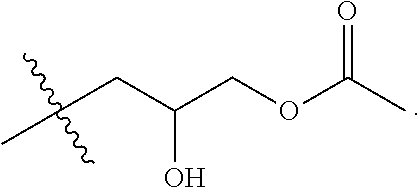
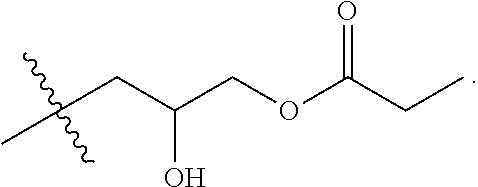
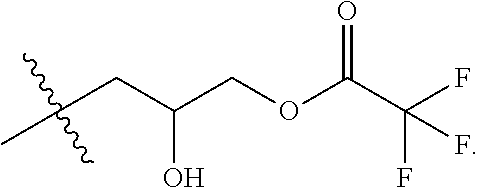
D00000
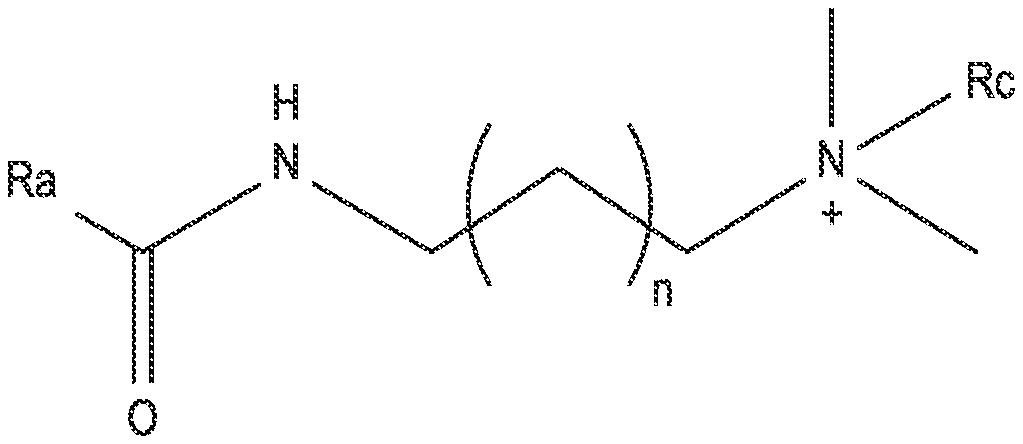
D00001
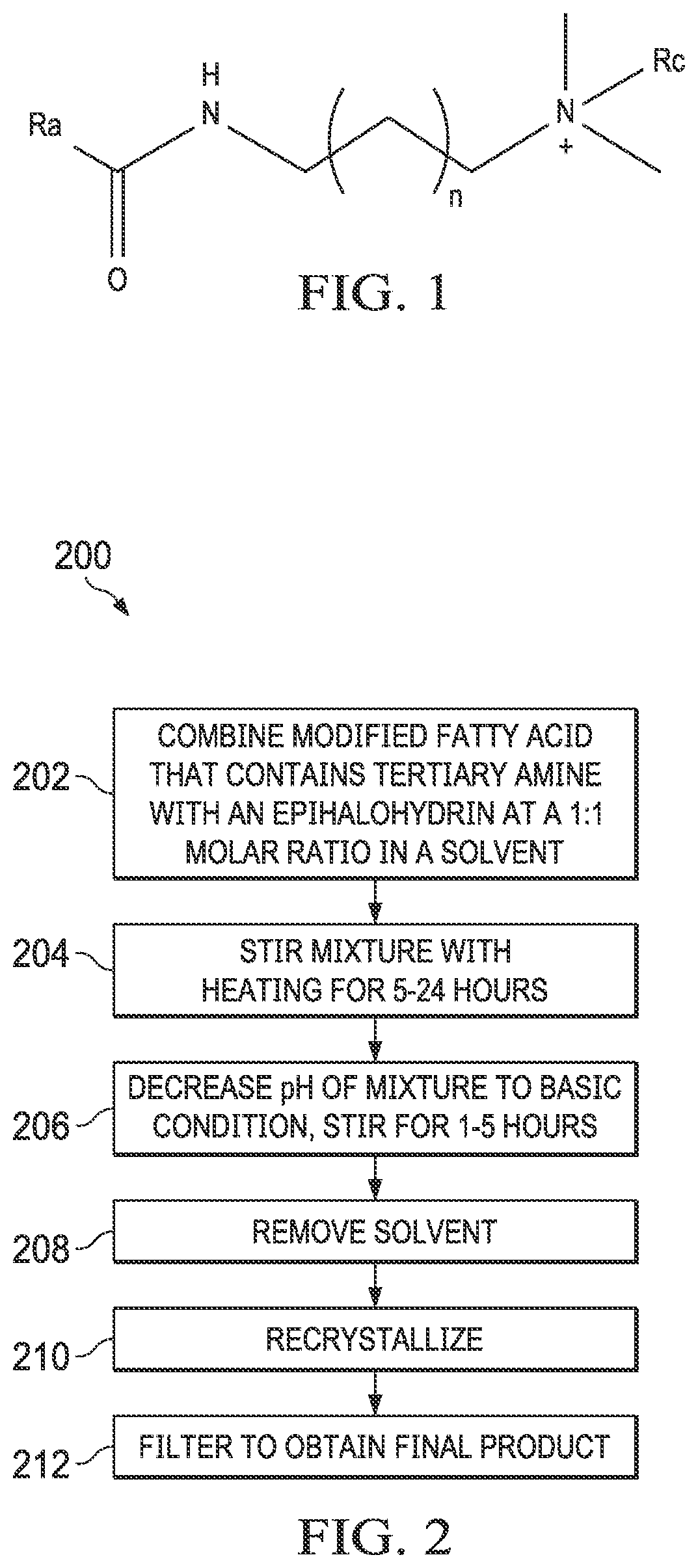
D00002
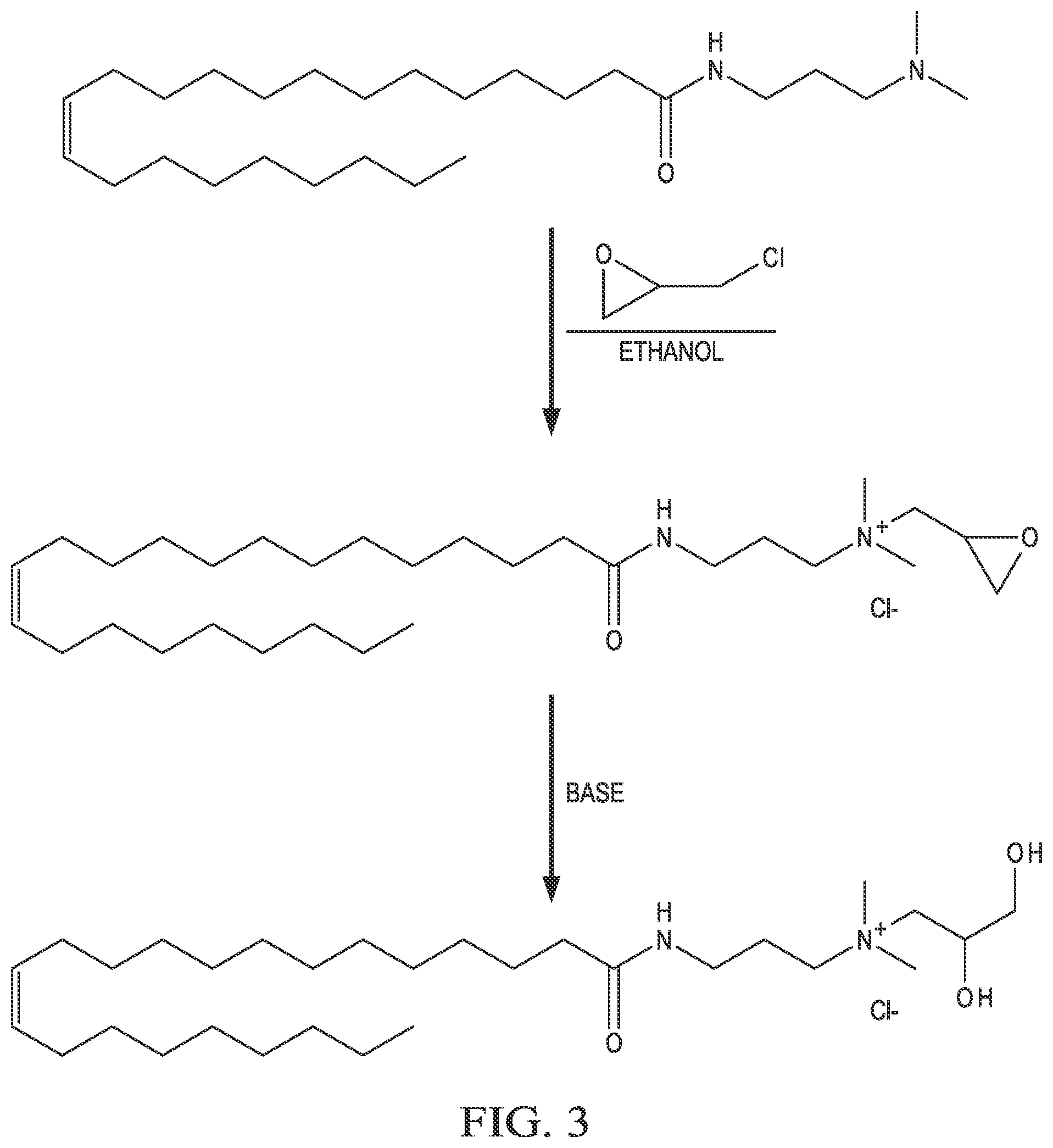
D00003

D00004
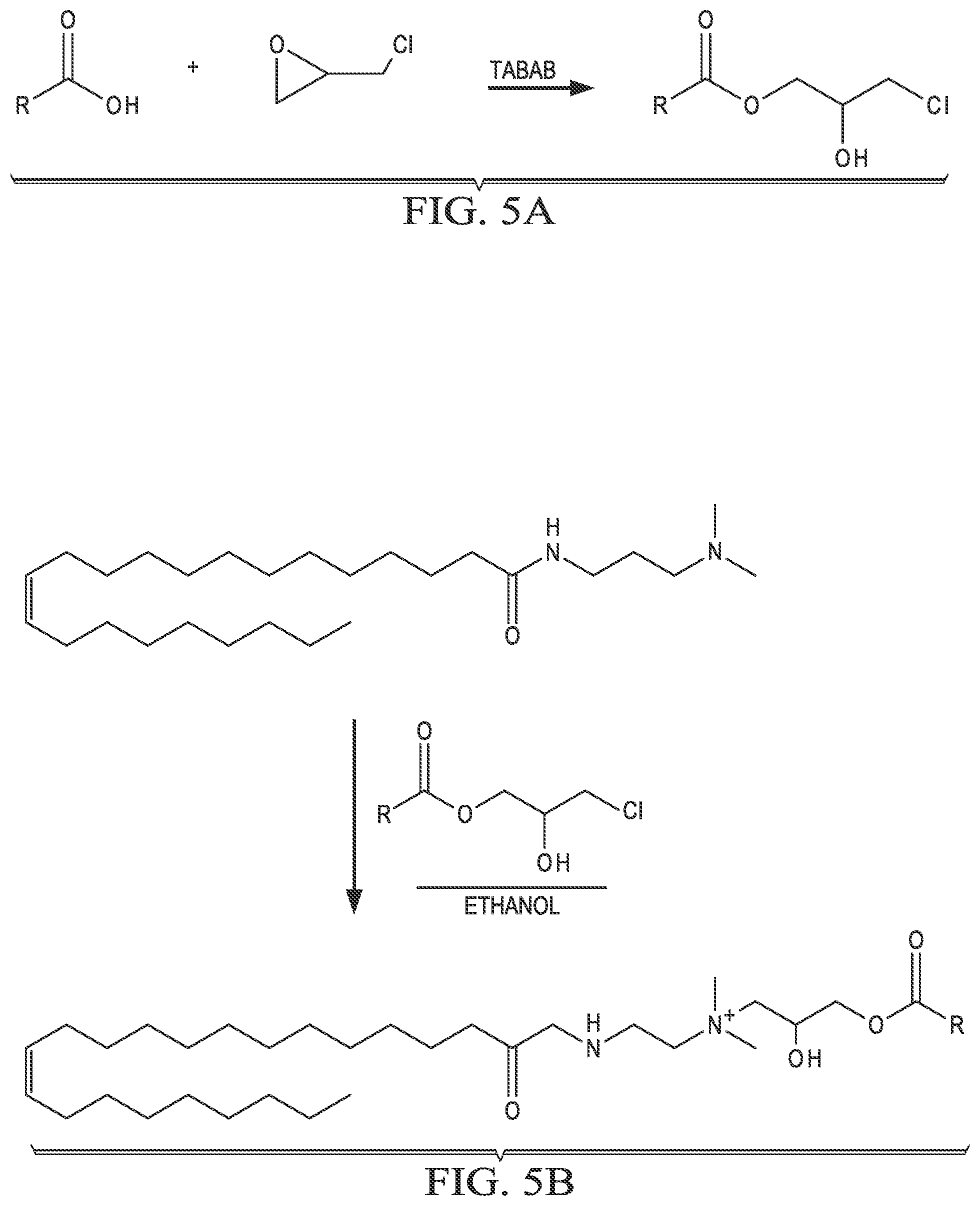
D00005
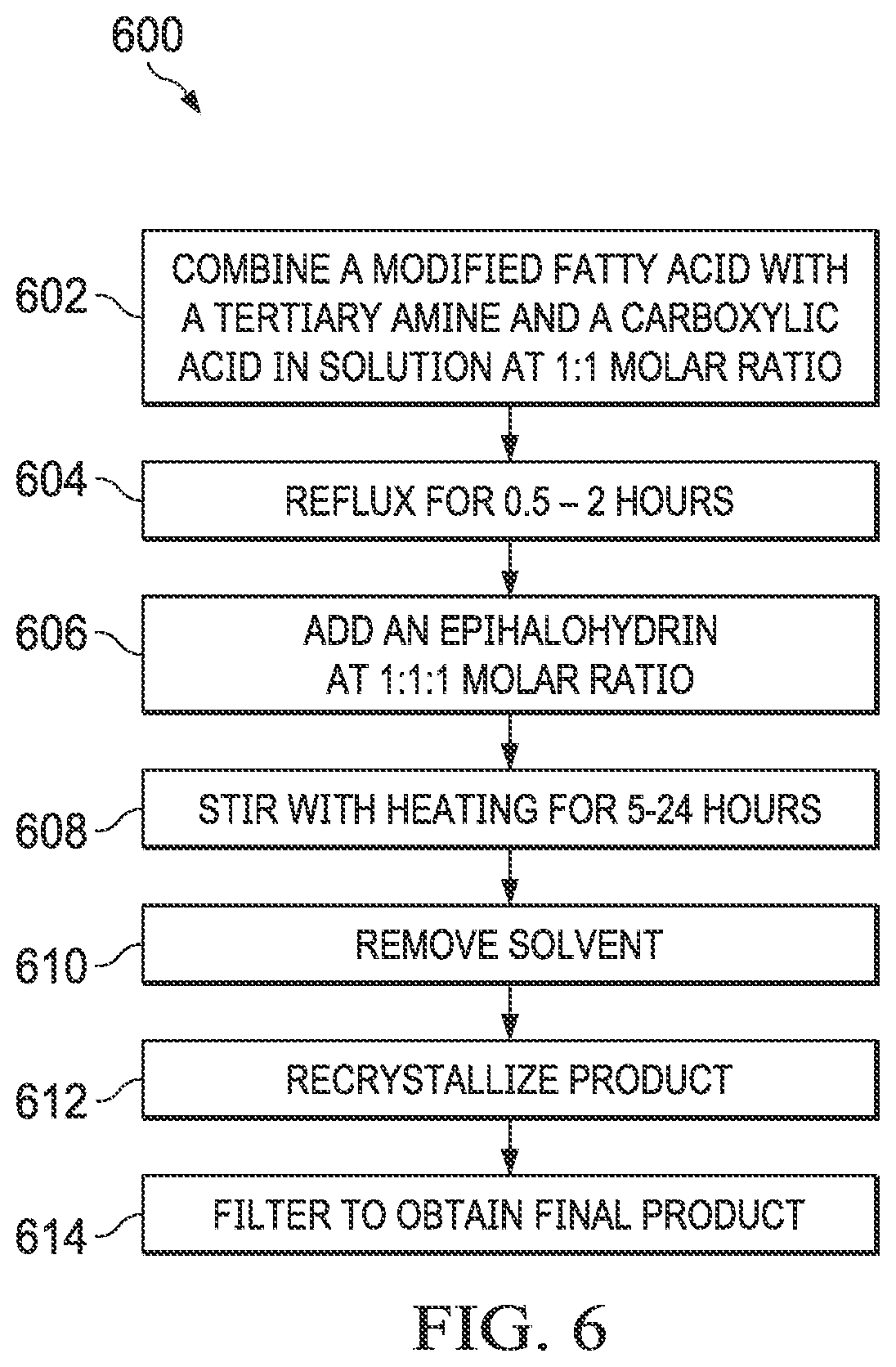
D00006

D00007

D00008
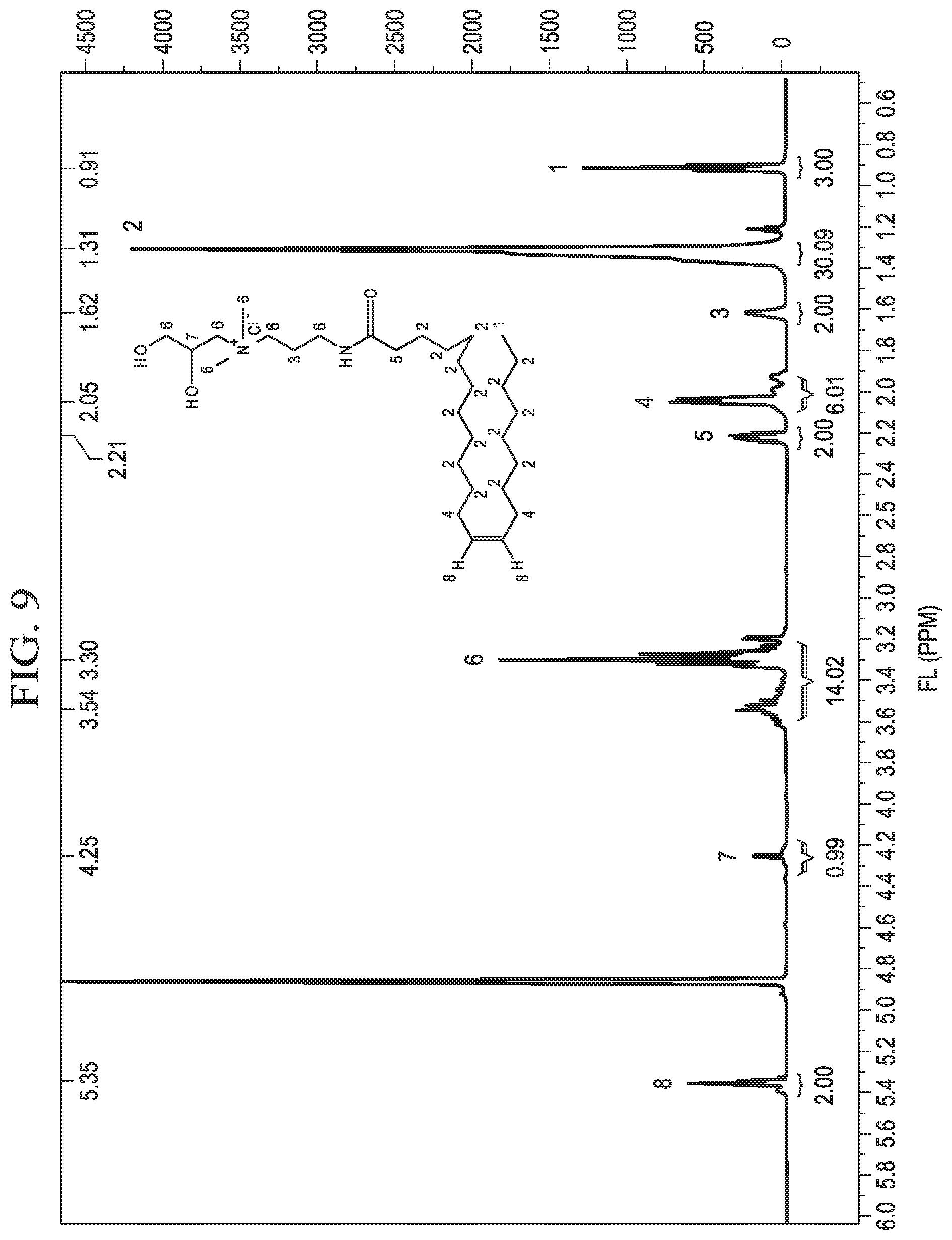
D00009
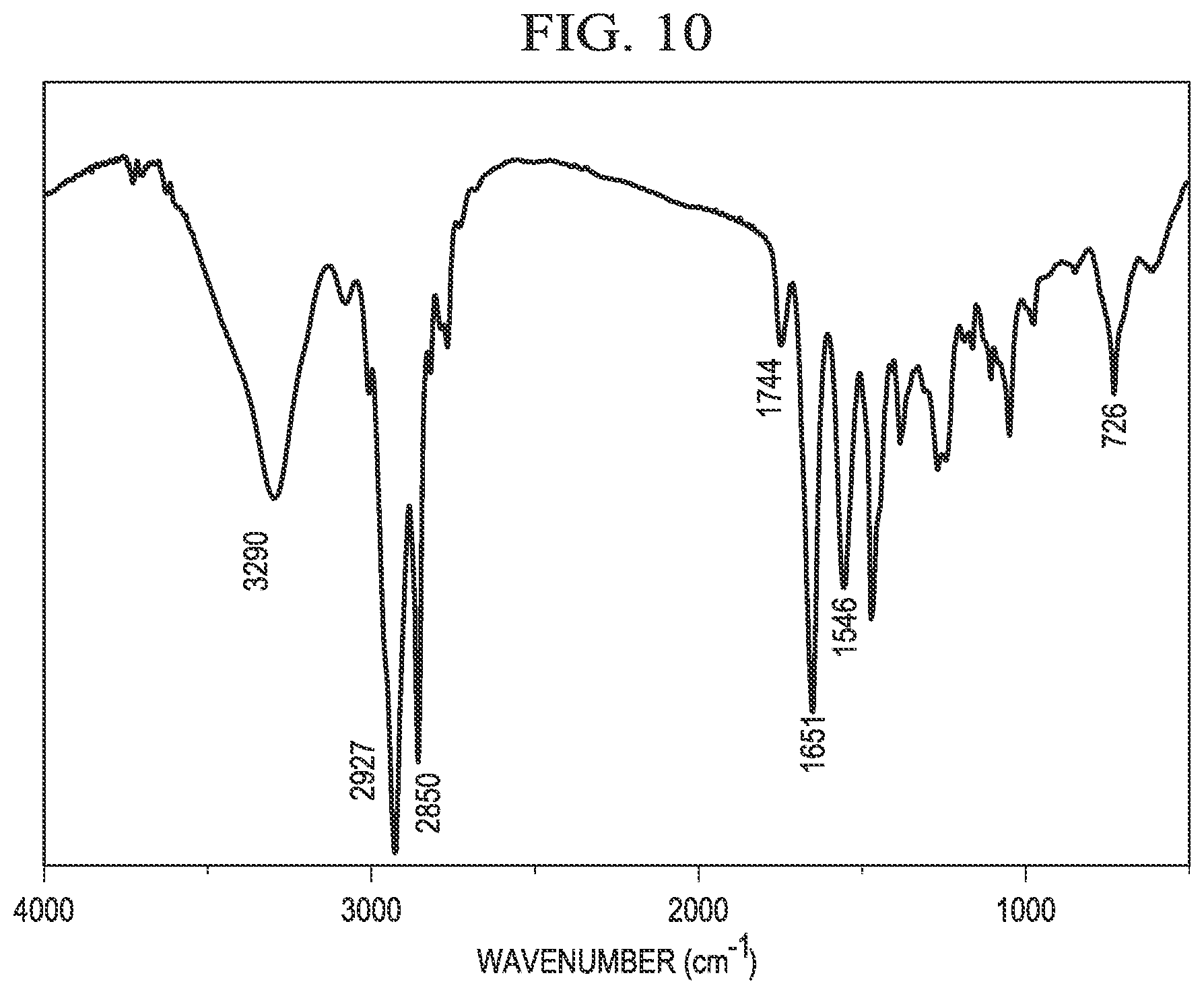
D00010
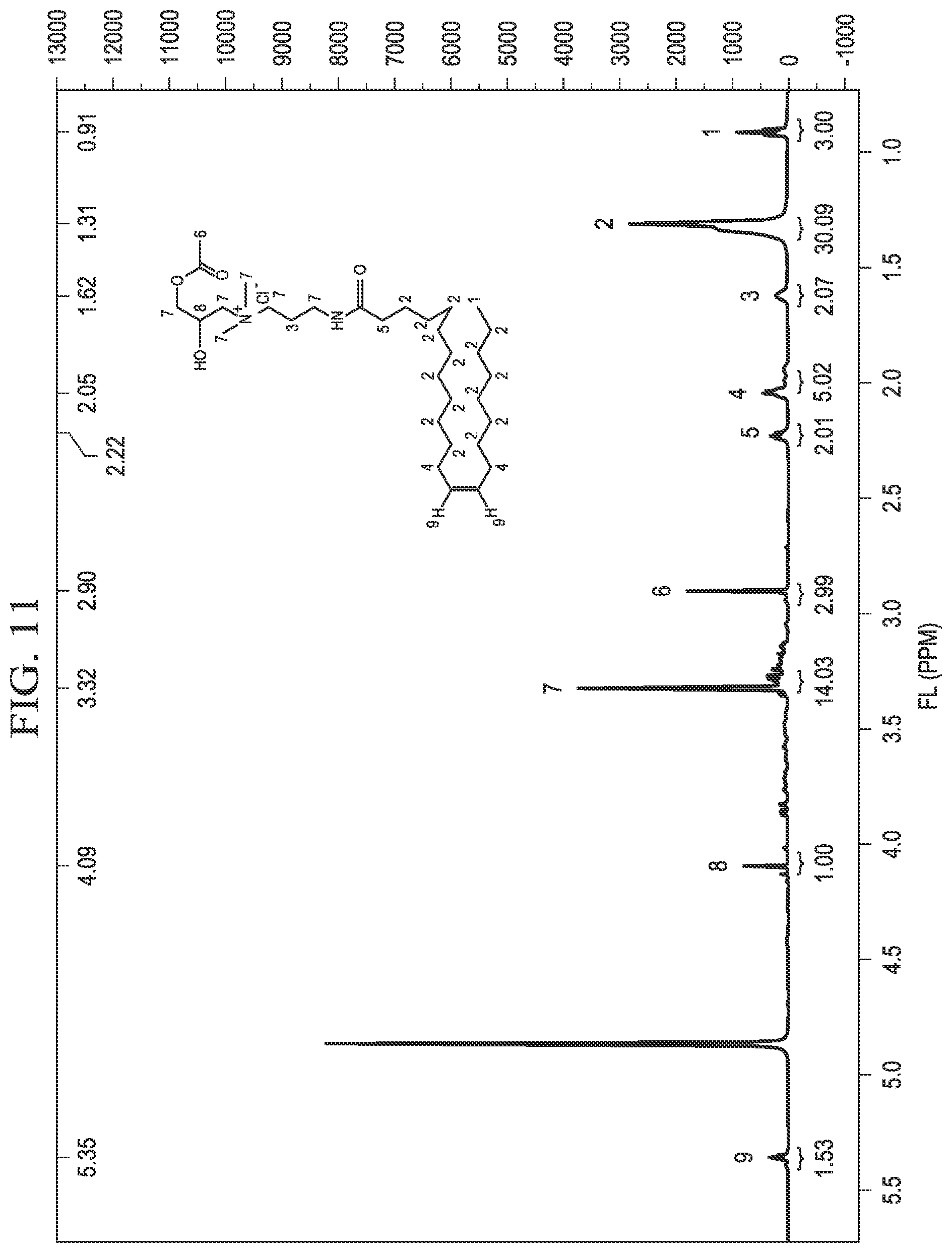
D00011
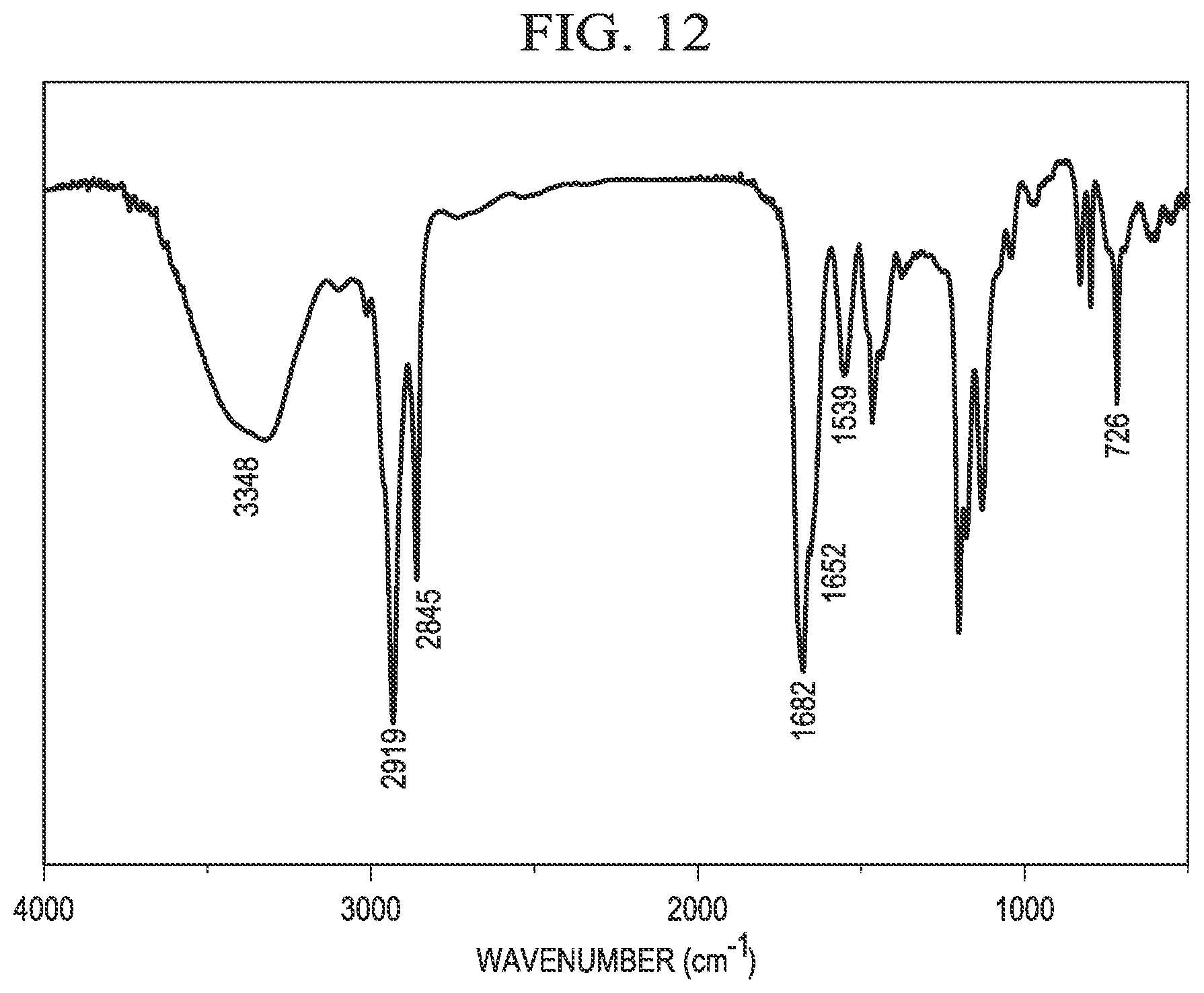
D00012
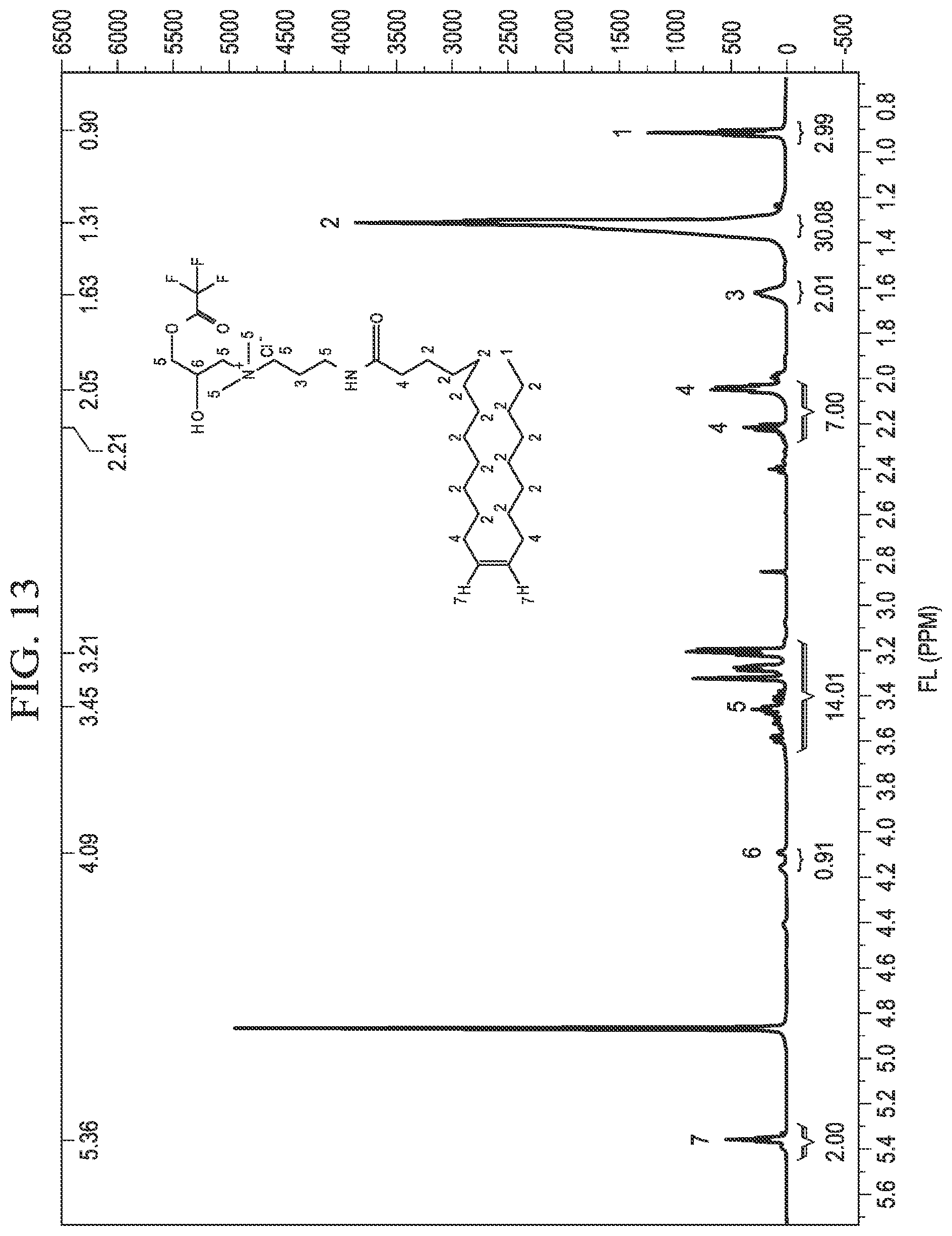
D00013
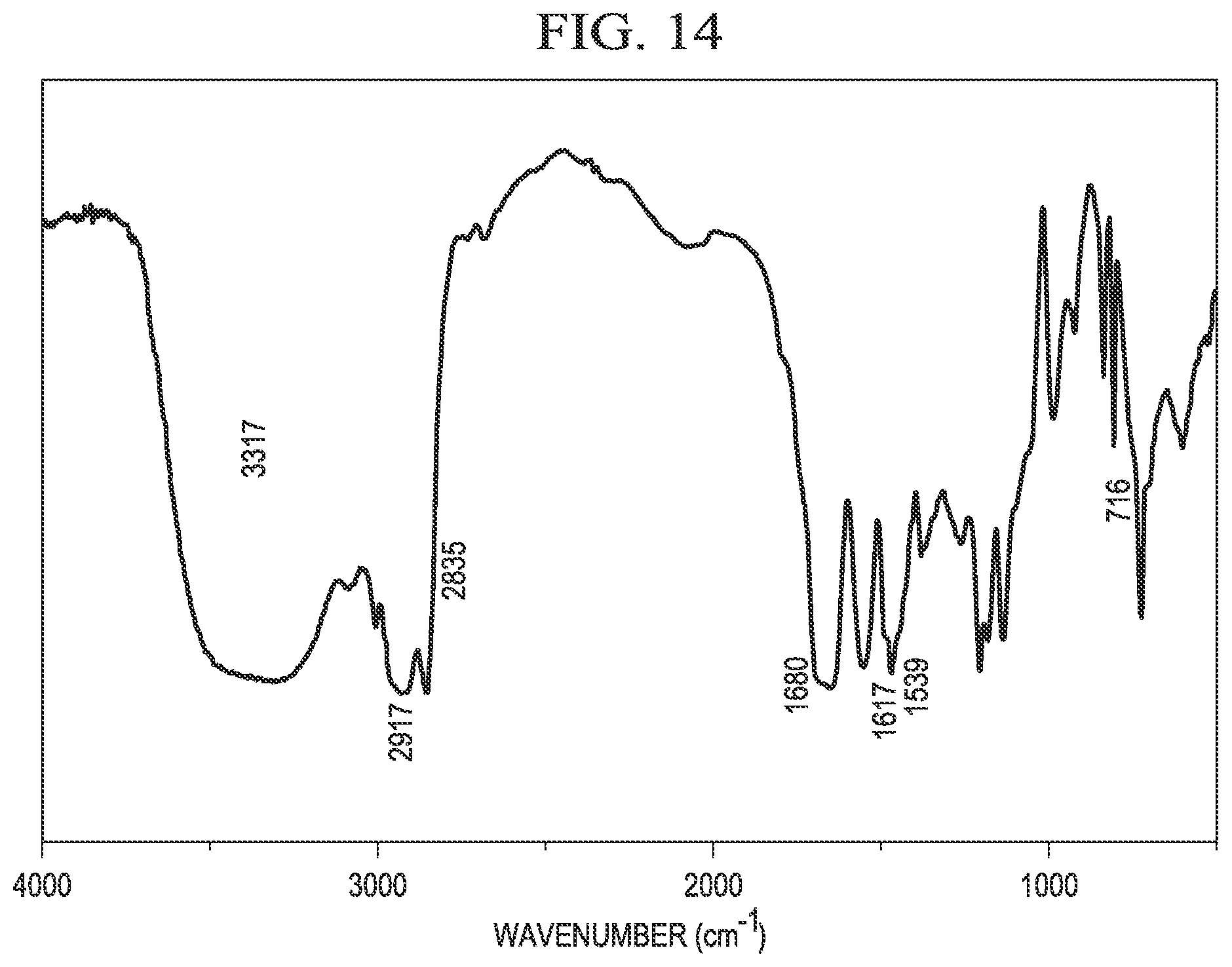
D00014
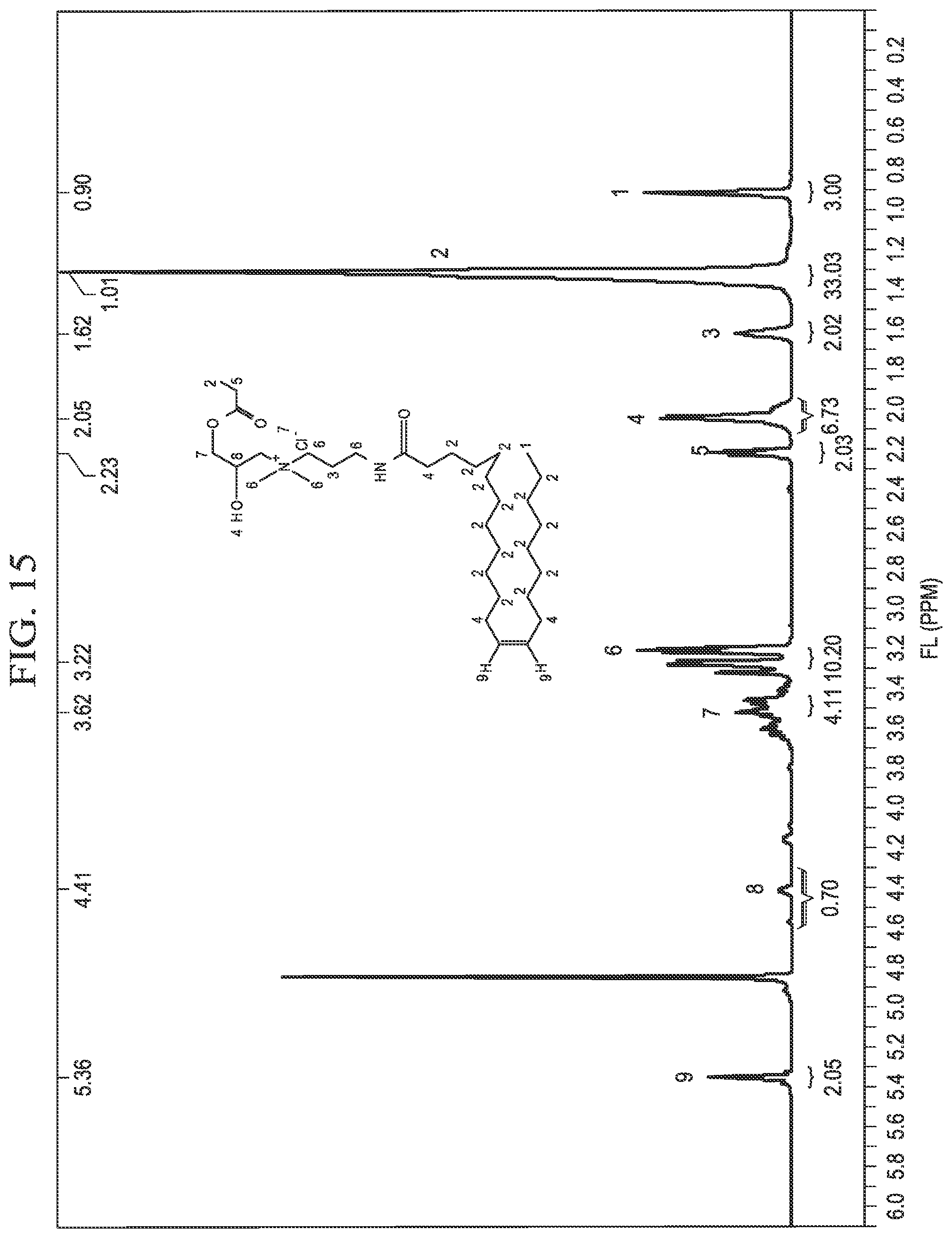
XML
uspto.report is an independent third-party trademark research tool that is not affiliated, endorsed, or sponsored by the United States Patent and Trademark Office (USPTO) or any other governmental organization. The information provided by uspto.report is based on publicly available data at the time of writing and is intended for informational purposes only.
While we strive to provide accurate and up-to-date information, we do not guarantee the accuracy, completeness, reliability, or suitability of the information displayed on this site. The use of this site is at your own risk. Any reliance you place on such information is therefore strictly at your own risk.
All official trademark data, including owner information, should be verified by visiting the official USPTO website at www.uspto.gov. This site is not intended to replace professional legal advice and should not be used as a substitute for consulting with a legal professional who is knowledgeable about trademark law.